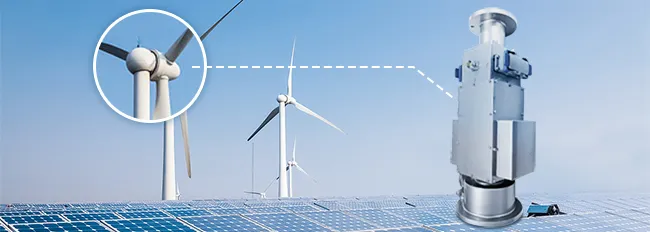Introduction
A seemingly small but pivotal component in the industrial realm, the slip ring’s RPM (Rotations Per Minute) plays a critical role in the dynamic functionality of a broad spectrum of machinery. From the massive gravity-defying turbines gracing our countryside to the highly specialized medical imaging equipment, all operate on the back of slip rings whirling at different RPMs. This crucial specification not only governs the effectiveness of the machine’s operation but also impacts its lifespan and maintenance cycles. Moreover, as the industry progresses towards automation and fast-paced processes, understanding the proper matching of RPMs has become vital. This article offers an in-depth understanding of slip ring RPMs, discussing what they are, how to select the appropriate ones, their applications, and detailed data for different types of slip rings. By the end of this article, readers will be better equipped to determine the correct RPMs for their slip ring selections, enabling improved productivity and system efficiency.
What Are Slip Ring RPMs?
Slip rings, an essential component in electrical and mechanical systems, play a crucial role in transferring power, data, or signals between a rotating structure and a stationary one. Widely known as rotary electrical connectors, slip rings facilitate reliable electrical connection and consistent transmission, even as the system is in constant motion.
RPM, or rotations per minute, is the measure of a slip ring’s rotation speed. In other words, it denotes the number of complete 360-degree revolutions the slip ring makes in one minute. It is a vital parameter to consider, as it directly influences factors such as operational efficiency, mechanical wear, signal stability, and overall performance of the slip ring.
A deep comprehension of slip ring RPMs is required to establish the ideal balance between rotation speed, transmission performance, and durability of the slip ring. RPMs that are too high can result in increased contact wear and tear, leading to shorter service life and the need for regular maintenance. On the other hand, RPMs that are too low may not provide the required rotational speed for the specific application, potentially compromising the system’s performance. Thus, understanding and selecting the right RPMs for slip rings in different applications is critical to ensure smooth and efficient operation.
How to Choose the Appropriate Slip Ring RPMs?
Choosing the right RPMs for slip rings is an essential task, especially given that this parameter directly affects system performance and lifespan. It requires careful consideration of several factors to make a suitable and efficient choice.
Firstly, it’s necessary to evaluate your equipment’s operational speed. For instance, a high-speed system requires a slip ring with higher RPMs, whereas a low-speed system can function efficiently with lower RPMs. Thus, a thorough understanding of machinery and application demands is crucial for the initial stages of RPM selection.
Secondly, consider the specific requirements of the application. For high-frequency data transmission or quick power transfer, slip rings with high RPMs are desirable. In a low-speed, steady-state operation, particularly those demanding precision, a lower RPM slip ring might be more suitable.
Thirdly, the environmental conditions where the slip ring will operate impact your choice. Conditions such as temperature, humidity, dust, and pressure can affect the rotational speed and overall performance of the slip ring over time. For instance, in high-temperature or high-pressure environments, you might need slip rings that can maintain stable RPMs under these conditions.
Beyond these, other factors that influence the selection include ease of maintenance, lifespan, and cost. High RPM slip rings often require more frequent maintenance and replacements due to increased wear and tear. Considering these aspects in advance can help in selecting slip rings with RPMs that strike a balance between performance and maintenance needs and remain cost-efficient.
Also, it’s always advisable to consult with a professional or manufacturer as they have the necessary industrial insight and can guide you in making a preferably suitable choice based on your specific conditions and requirements. Doing so will ensure your slip ring RPM choice aligns well with your system’s needs, providing both operational efficiency and longevity.
Application of Slip Ring RPMs with Different Values
The choice of slip ring RPMs has a substantial impact on a variety of applications, given the role they play in the transfer of power and data. The selection is predominantly dependent on the speed of operation and the required precision in each application.
Here are some instances that illustrate the application of different RPMs:
| High-speed Applications | In scenarios that necessitate high-speed operation and rapid data transfer, a high RPM slip ring would be ideal. For example, in advanced medical imaging technologies such as CT scanners or MRI machines, slip rings with high RPMs are employed to enable swift data transfer between stationary and rotating parts, thus speeding up the imaging process. |
| Heavy Machinery and Industrial Applications | Within industries that employ substantial machinery, such as wind turbines or heavy-duty industrial rotary tables, slip rings with wide-ranging RPMs are used. The selection here is dependent on the functioning speed of the mechanical system. |
| Precision-based Applications | In instances where precise and steady data or signal transfer is required, lower RPM slip rings are suitable. Examples include CCTV systems that need a steady transfer of video signals from the rotating camera to the stationary system. |
| Military and Aerospace Applications | Considering the diverse and high-stakes scenarios faced in the military and aerospace industry, it's not uncommon for a range of slip-ring RPMs to be employed. Their use varies from low RPMs in precise satellite tracking systems to higher RPMs in radar and surveillance systems. |
| Robotic Applications | Robotics is another sphere where slip rings play a pivotal role. Depending on the speed and precision required for the operation, both low and high RPM slip rings can be used. For instance, high-speed assembly robots might employ high RPM slip rings, while delicate operations like robotic surgery may utilize low RPM slip rings. |
These examples underline the importance of matching the RPMs of the slip ring appropriately with the requirements of the application. Understanding the situation thoroughly while selecting the RPM can lead to improved system efficiency, productivity, and overall service life.
Slip Ring RPMs and Productivity
The relationship between slip ring RPMs and productivity is an intricate one. While higher RPMs can lead to increased operational speed and productivity, they can also introduce challenges, such as faster wear and tear, increased noise, and potential loss in signal integrity. Striking the right balance is essential to ensure efficient, reliable, and productive operation, without compromising system longevity.
Here is a deeper look at how slip ring RPMs can impact productivity:
| Increased Operational Speed | High RPM slip rings enable swift data transmission and high-speed operation, directly contributing to increased productivity. For example, production assembly lines or high-speed sorting systems rely on slip rings with high RPMs to maintain their fast-paced operations. |
| Optimal Signal Integrity | The RPM of a slip ring affects data transmission quality and integrity. A well-matched RPM ensures stable data transmission, minimizing issues such as signal noise and jitter, and avoiding loss of critical information. This aspect can play a crucial part in high-stakes applications such as military or satellite communication. |
| Mechanical Wear | A higher RPM can lead to faster wear on the brushes and contact surfaces, ultimately affecting the slip ring's service life. Frequent maintenance, replacements, and potential downtimes can decrease overall productivity. As a result, choosing the appropriate RPM based on the machine system's requirements is crucial to keep a balance between high productivity and minimal wear. |
| Load Capacity | In cases where a slip ring needs to transfer large amounts of power, a higher RPM may be suitable. This is because the heat generated during power transmission is more effectively dissipated with increased rotation, facilitating the transfer of greater loads. |
Understanding these factors and their implications helps users choose a slip ring with an optimal RPM range that meets their performance needs while minimizing wear and maintenance. This balance is essential for increasing productivity without jeopardizing the machine’s lifespan or efficiency.
Slip Ring RPMs Data of Different Types of Slip Rings
Different types of slip rings have unique RPM ranges, which are primarily influenced by their construction, mechanism of transfer, and intended use. Each variety accommodates distinct operational demands and is suitable for specific applications. Let’s take a deeper look at three major types – miniature slip rings, through-hole slip rings, and pancake slip rings.
Capsule Slip Ring
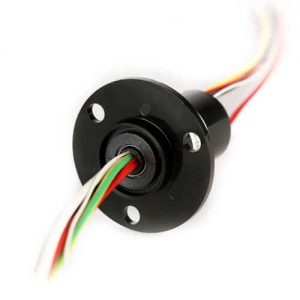
Capsule slip rings are often offered in a compact size with flange-like miniature slip rings, used for electrical power transmission and data transfer between a stationary and a rotating part. Capsule Slip Rings also have the rotor, stator, brush block, bearing, and housing. They are easily installed and widely used in small and medium-sized equipment, such as speed dome cameras, intelligent toys, stage lights drones, etc.
Miniature Slip Rings
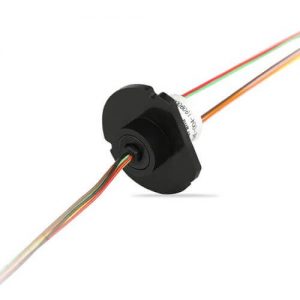
A miniature slip ring assembly is specially designed for small installation spaces. Also called a small slip ring, mini slip ring, compact slip ring, or micro slip ring. A miniature slip ring is the extension of a capsule slip ring and through the through-bore slip ring. The miniature package units have been designed to offer an economical and compact solution for signal and power transmission between the rotor and stator side. Shaft or flange are the two main mounting methods.
PCB Slip Ring
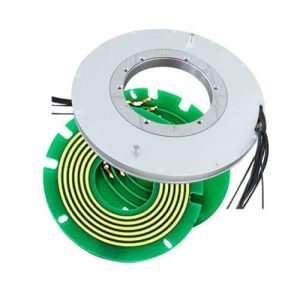
PCB slip ring is a kind of pancake slip ring, also called ultrathin flat slip ring. A common form of flat slip ring and made up of two parts, ring surface and brush assembly. The ring surface circuit board with an ultra-thick copper layer, then copper plating, and hard gold plating, so the PCB slip rings have high hardness and wear resistance features.
PIN Slip Rings
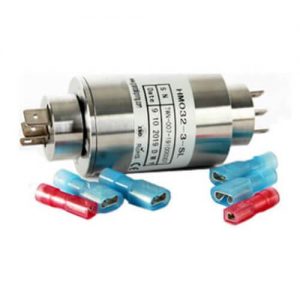
Pin slip rings are the substitute for mercury slip rings. Mercury slip rings use liquid metal mercury as a transmission medium. Special sealing technology, insulation, and compact design made them outstanding features like extremely long working life, low electrical noise, and contact resistance. Mercury is a chronic toxic substance. There have great potential threat to both the environment and the operators if leaked. People have been actively searching for alternative products.
Model | Picture | No. of Rings | OD(mm) | Rated Current | RPM | IP | |
2 | 32 | 20A | 0~400 | IP54 | |||
2 | 32 | 20A | 0~400 | IP65 | |||
2 | 32 | 20A | 0~400 | IP68 | |||
3 | 32 | 5A/20A | 0~400 | IP54 | |||
3 | 32 | 5A/20A | 0~400 | IP65 | |||
3 | 32 | 5A/20A | 0~400 | IP68 | |||
4 | 32 | 5A/20A | 0~400 | IP54 | |||
4 | 32 | 5A/20A | 0~400 | IP65 | |||
4 | 32 | 5A/20A | 0~400 | IP68 | |||
5 | 32 | 5A/20A | 0~400 | IP54 | |||
5 | 32 | 5A/20A | 0~400 | IP65 | |||
5 | 32 | 5A/20A | 0~400 | IP68 |
Pancake Slip Ring
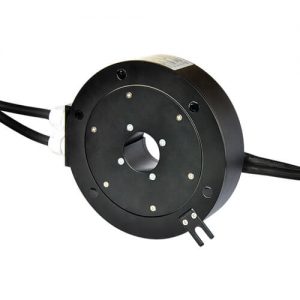
The pancake slip ring is similar to through through-hole slip ring but is especially used for the rotating system with a height limit. Also called a flat slip ring, flat disc electrical slip ring, or platter slip ring, since the shape is similar to a platter, rings, and brushes contact around the center of the circle. Pancake slip ring components include stator, rotor, and contacts, mainly used for transmitting precise signals and power or combined with pneumatic and hydraulic media. More electrical power, current, and signal circuits can extend broadwise limitless on flat diameter.
Pancake slip rings can be configured in two types, integrated and separated.
Integrated ring types can be designed for solid or through-hole rotating systems.
The separated ring type is composed of a separated rotor and contact brush, which can be designed with PCB.
High Speed Slip Ring
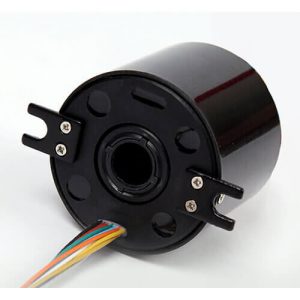
A slip ring can reach 2000 rpm and work stable, even above 4000 rpm.
Model | No. of Rings | ID(mm) | OD(mm) | Max Speed | |
3 | -- | 12 | 800 rpm | ||
10 | 8 | 54 | 2000 rpm | ||
10 | 20 | 78 | 2000 rpm | ||
10 | 35 | 99 | 2000 rpm | ||
10 | 45 | 120 | 2000 rpm | ||
10 | 55 | 135 | 2000 rpm | ||
18 | -- | 30 | 2000 rpm | ||
36 | -- | 33 | 2000 rpm |
1 Passage Pneumatic + Electrical Rotary Joints
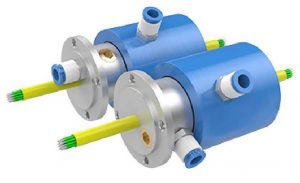
◆ Support M5, G1 / 8, G1 / 4, G3 / 8, G1 / 2, G3 / 4, G1 thread for pneumatic
◆ Dynamic sealing technology
◆ With NSK high precision bearing
◆ Abrasion resistant, low torque, high speed
◆ Can be combined to transfer 2~96 circuits power and signal
| Electrical Data | Mechanical Data | ||
|---|---|---|---|
| Rated Voltage | Power: 0~440 VAC/VDC Signal: 0~240 VAC/VDC | Max. Speed | 400RPM |
| Insulation Resistance | Power: ≥1000MΩ/500VDC Signal: ≥1000MΩ/500VDC | Max. Pressure | 10Bar |
| Insulation Strength | 500VAC@50Hz, 60s | Working Temperature | -30℃~+80℃ |
| Lead Wires | Standard (adjustable) | Working Humidity | 0~85% RH |
| Lead Length | Standard 300mm (adjustable) | Housing Material | Aluminum Alloy |
| Electrical Noise | <0.01Ω | Protection Grade | IP51 |
2 Passage Pneumatic/Hydraulic + Electrical Rotary Joint
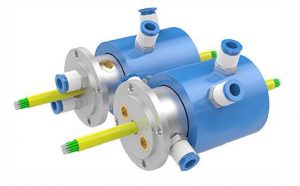
◆ Can replace SMC series pneumatic rotary joint
◆ Can combine to transmit power and signals
◆ Standard ports M5, can be G1/8, G1/4, G3/8, G1/2, G3/4
◆ Specification can be customized
◆ Housing Material, Stainless Steel/Aluminum Alloy
◆ Working Temperature, -40℃-+80℃
◆ Working Humidity, 10-85% RH
◆ Protection Grade, IP51
| Model | Passages | Circuits(2A) | Torque | Negative Vacuum | Max. Pressure | Max. Speed |
|---|---|---|---|---|---|---|
| MQR2 | 2 Passages, Port M5 | / | 0.2N.m | -1.5kPa | 1Mpa | 300rpm |
| MQR2-S12 | 2 Passages, Port M5 | 12 Circuits | 0.2N.m | -1.5kPa | 1Mpa | 300rpm |
| MQR2-S24 | 2 Passages, Port M5 | 24 Circuits | 0.2N.m | -1.5kPa | 1Mpa | 300rpm |
4 Passage Pneumatic/Hydraulic + Electrical Rotary Joint

◆ Can replace SMC series pneumatic rotary joint
◆ Can combine to transmit power and signals
◆ Standard ports M5, can be G1/8, G1/4, G3/8, G1/2, G3/4
◆ Specification can be customized
◆ Housing Material, Stainless Steel/Aluminum Alloy
◆ Working Temperature, -40℃-+80℃
◆ Working Humidity, 10-85% RH
◆ Protection Grade, IP51
| Model | Passages | Circuits(2A) | Torque | Negative Vacuum | Max. Pressure | Max. Speed |
|---|---|---|---|---|---|---|
| MQR4 | 4 Passages, Port M5 | / | 0.3N.m | -1.5kPa | 1Mpa | 300rpm |
| MQR4-S12 | 4 Passages, Port M5 | 12 Circuits | 0.3N.m | -1.5kPa | 1Mpa | 300rpm |
| MQR4-S24 | 4 Passages, Port M5 | 24 Circuits | 0.3N.m | -1.5kPa | 1Mpa | 300rpm |
6 Passage Pneumatic/Hydraulic + Electrical Rotary Joint

◆ Can replace SMC series pneumatic rotary joint
◆ Can combine to transmit power and signals
◆ Standard ports M5, can be G1/8, G1/4, G3/8, G1/2, G3/4
◆ Specification can be customized
◆ Housing Material, Stainless Steel/Aluminum Alloy
◆ Working Temperature, -40℃-+80℃
◆ Working Humidity, 10-85% RH
◆ Protection Grade, IP51
| Model | Passages | Circuits(2A) | Torque | Negative Vacuum | Max. Pressure | Max. Speed |
|---|---|---|---|---|---|---|
| MQR6 | 6 Passages, Port M5 | / | 0.5N.m | -1.5kPa | 1Mpa | 300rpm |
| MQR6-S12 | 6 Passages, Port M5 | 12 Circuits | 0.5N.m | -1.5kPa | 1Mpa | 300rpm |
| MQR6-S24 | 6 Passages, Port M5 | 24 Circuits | 0.5N.m | -1.5kPa | 1Mpa | 300rpm |
8 Passage Pneumatic/Hydraulic + Electrical Rotary Joint

◆ Can replace SMC series pneumatic rotary joint
◆ Can combine to transmit power and signals
◆ Standard ports M5, can be G1/8, G1/4, G3/8, G1/2, G3/4
◆ Specification can be customized
◆ Housing Material, Stainless Steel/Aluminum Alloy
◆ Working Temperature, -40℃-+80℃
◆ Working Humidity, 10-85% RH
◆ Protection Grade, IP51
| Model | Passages | Circuits(2A) | Torque | Negative Vacuum | Max. Pressure | Max. Speed |
|---|---|---|---|---|---|---|
| MQR8 | 8 Passages, Port M5 | / | 0.7N.m | -1.5kPa | 1Mpa | 300rpm |
| MQR8-S12 | 8 Passages, Port M5 | 12 Circuits | 0.7N.m | -1.5kPa | 1Mpa | 300rpm |
| MQR8-S24 | 8 Passages, Port M5 | 24 Circuits | 0.7N.m | -1.5kPa | 1Mpa | 300rpm |
10 Passage Pneumatic/Hydraulic + Electrical Rotary Joints
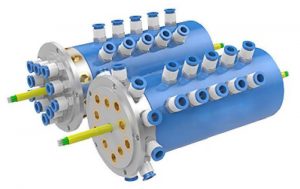
◆ Support M5, G1 / 8, G1 / 4, G3 / 8, G1 / 2, G3 / 4, G1 thread for pneumatic
◆ Dynamic sealing technology
◆ With NSK high precision bearing
◆ Abrasion resistant, low torque, high speed
◆ Can be combined to transfer 2~96 circuits power and signal
| Electrical Data | Mechanical Data | ||
|---|---|---|---|
| Rated Voltage | Power: 0~440 VAC/VDC Signal: 0~240 VAC/VDC | Max. Speed | 400RPM |
| Insulation Resistance | Power: ≥1000MΩ/500VDC Signal: ≥1000MΩ/500VDC | Max. Pressure | 10Bar |
| Insulation Strength | 500VAC@50Hz, 60s | Working Temperature | -30℃~+80℃ |
| Lead Wires | Standard (adjustable) | Working Humidity | 0~85% RH |
| Lead Length | Standard 300mm (adjustable) | Housing Material | Aluminum Alloy |
| Electrical Noise | <0.01Ω | Protection Grade | IP51 |
12 Passage Pneumatic/Hydraulic + Electrical Rotary Joint
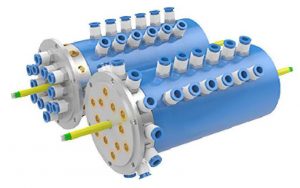
◆ Can replace SMC series pneumatic rotary joint
◆ Can combine to transmit power and signals
◆ Standard ports M5, can be G1/8, G1/4, G3/8, G1/2, G3/4
◆ Specification can be customized
◆ Housing Material, Stainless Steel/Aluminum Alloy
◆ Working Temperature, -40℃-+80℃
◆ Working Humidity, 10-85% RH
◆ Protection Grade, IP51
| Model | Passages | Circuits(2A) | Torque | Negative Vacuum | Max. Pressure | Max. Speed |
|---|---|---|---|---|---|---|
| MQR12 | 12 Passages, Port M5 | / | 1.0N.m | -1.5kPa | 1Mpa | 300rpm |
| MQR12-S12 | 12 Passages, Port M5 | 12 Circuits | 1.0N.m | -1.5kPa | 1Mpa | 300rpm |
| MQR12-S24 | 12 Passages, Port M5 | 24 Circuits | 1.0N.m | -1.5kPa | 1Mpa | 300rpm |
16 Passage Pneumatic/Hydraulic + Electrical Rotary Joint

◆ Can replace SMC series pneumatic rotary joint
◆ Can combine to transmit power and signals
◆ Standard ports M5, can be G1/8, G1/4, G3/8, G1/2, G3/4
◆ Specification can be customized
◆ Housing Material, Stainless Steel/Aluminum Alloy
◆ Working Temperature, -40℃-+80℃
◆ Working Humidity, 10-85% RH
◆ Protection Grade, IP51
| Model | Passages | Circuits(2A) | Torque | Negative Vacuum | Max. Pressure | Max. Speed |
|---|---|---|---|---|---|---|
| MQR16 | 16 Passages, Port M5 | / | 1.3N.m | -1.5kPa | 1Mpa | 300rpm |
| MQR16-S12 | 16 Passages, Port M5 | 12 Circuits | 1.3N.m | -1.5kPa | 1Mpa | 300rpm |
| MQR16-S24 | 16 Passages, Port M5 | 24 Circuits | 1.3N.m | -1.5kPa | 1Mpa | 300rpm |
MQR Series Pneumatic Rotary Joints
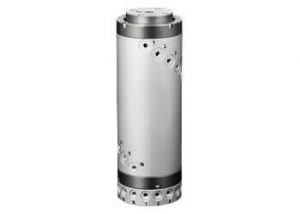
◆ Supported by double high-precision maintenance-free bearing for high stability
◆ High-quality imported sealing parts for prolonged service life
◆ Stainless steel rotor with special treatment to provide good durability
◆ Housing material available in aluminum, stainless steel, or brass
◆ Special leakage reflux design to avoid exterior contamination
◆ Customization available for different applications
| Technical Ratings | |||
|---|---|---|---|
| Max. Speed | Max. Pressure | Temperature | Media |
| 2000r/min | 1.1 Mpa | -10℃~+80℃ | Air |
MP Series Pneumatic/Hydraulic Rotary Joints
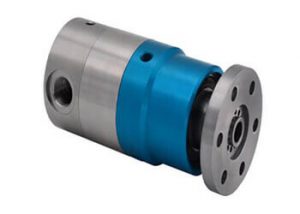
◆ Multichannel mechanical sealing structure suitable for high-speed rotating applications also
◆ Double imported ball bearing for high stability
◆ Multi-spring design efficient spring compensation
◆ Balanced mechanical sealing structure for prolonged service life
◆ Drainage hole design for wearing and leakage observation
| Technical Ratings | |||
|---|---|---|---|
| Max Speed | Temperature | Media | Media |
| 3000r/min | -30℃~+120℃ | Air or Water, Max. Pressure 1.1 Mpa | Hydraulic Oil, Max. Pressure 7 Mpa |
MLA Series Pneumatic Rotary Joints
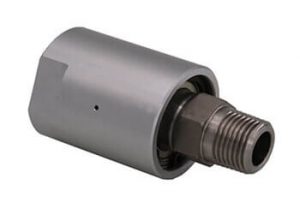
◆ Supported by double high-precision maintenance-free bearing for high stability
◆ High-quality imported sealing parts for prolonged service life
◆ Stainless steel rotor with special treatment to provide good durability
◆ Housing material available in aluminum, stainless steel, or brass
◆ Special leakage reflux design to avoid exterior contamination
◆ Customization available for different applications
| Technical Ratings | |||
|---|---|---|---|
| Max Speed | Max Pressure | Temperature | Media |
| 2000r/min | 1.1 Mpa | -30℃~+80℃ | Air |
MH Series Hydraulic Rotary Joints
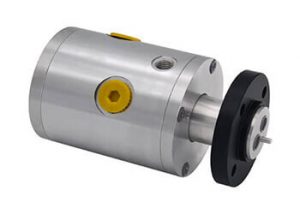
◆ Supported by double high-precision maintenance-free bearing for high stability
◆ High-quality imported sealing parts for prolonged service life
◆ Stainless steel rotor with special treatment to provide good durability
◆ Housing material available in aluminum, stainless steel, or brass
◆ Special leakage reflux design to avoid exterior contamination
◆ Customization available for different applications
| Technical Ratings | |||
|---|---|---|---|
| Max. Speed | Max. Pressure | Temperature | Media |
| 300r/min | 30 Mpa | -30℃~+80℃ | Oil, Air or Similar |
Notes
- Operations under extreme ratings should be avoided. Maximal working speed is in reverse proportion to working pressure and is also influenced by the media lubricity and the heat dissipation ability of the sealing components. When the rotation speed is lower than 10RPM, the maximal pressure can be up to 30Mpa.
- Inner leakage is allowed between each passage. Please pay attention to the compatibility of different working media to avoid cross-contamination.
- The working fluid or hydraulic media should be filtered before being used. The filtration precision should be no lower than 10um.
- A drainage hole is accompanied for observation and collection of escaping media.
- For other applications, please consult AIKE SEALING beforehand.
Wind turbine Hydraulic Rotary Joints
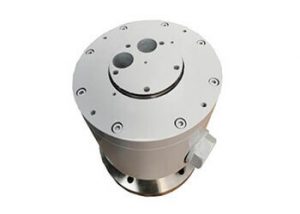
◆ Supported by double high-precision maintenance-free bearing for high stability
◆ Special sealing structure designed for high-speed and high-pressure application that provides prolonged failure-free operation
◆ Low rotation torque
◆ Special structure to be free from friction heat under high-speed
◆ Running torque unaffected by working pressure and temperature change.
◆ Max working speed up to 6500RPM
◆ Drainage hole design to avoid exterior contamination
◆ Customization available for different customer applications
| Technical Ratings | |||
|---|---|---|---|
| Max Speed | Max Pressure | Temperature | Media |
| 6500r/min | 30 Mpa | -30℃~+80℃ | Hydraulic, Oil |
Notes
- MK Series uses a labyrinth sealing structure. During installation and operation, the drainage hole L must be connected by an oil pipe to the oil collection tank. And the oil pipe must not be blocked to avoid back pressure.
- Inner leakage is allowed between each passage. Please pay attention to the compatibility of different working media to avoid cross-contamination.
- The working fluid or hydraulic media should be filtered before being used. The filtration precision should be no lower than 10um.
- Working temperature rise will reduce the viscosity of the working fluid to increase the leakage volume. So during operation, the cooling device should be accompanied.
- The hydraulic system should be equipped with an automatic pressure regulator to compensate for the pressure loss caused by inner leakage.
These examples demonstrate how the RPM data of slip rings varies with type, each offering unique advantages to different scenarios. They underline the significance of selecting the appropriate RPM based on both the slip ring type and the specific application requirements.
Buying Tips about Slip Ring RPMs
When it comes to purchasing slip rings, choosing the right RPM is a significant consideration. Here are some tips that can assist in making an informed decision:
Understand Your Application Needs
It’s crucial to understand the requirements of the systems or machinery where the slip ring will be used. Take into account factors like operational speed, the need for precision, and power and data transfer requirements when determining the ideal RPM.
Evaluate Environmental Conditions
The environment where the slip ring will operate greatly impacts its performance. High-temperature or high-pressure environments might demand slip rings that maintain stable RPMs under these conditions. If the slip ring will operate in a dusty condition, ensure it has proper sealing, as dust can affect the rotational speed and overall performance.
Consider Maintenance and Lifespan
Higher RPMs can cause faster wear and tear on the contact surfaces and brushes of the slip rings, reducing their service life. If maintenance convenience, long life, and less frequent replacements matter to you, opt for RPMs that harmonize the performance and maintenance needs.
Consult with Professionals or Manufacturers
Manufacturers or industry professionals can provide valuable insights based on their expertise and experiences. Leverage their knowledge to understand which slip rings with what RPMs would suit your specific conditions and requirements.
Keep an Eye on Budget
Although high RPM slip rings might offer quicker operation, they may require more frequent replacements, adding extra cost in the long run. Make a cost-effective decision considering both the initial purchase price and potential maintenance or replacement costs.
These tips stress the importance of a balanced decision that considers technical requirements, operational environment, maintenance needs, professional advice, and budget constraints when buying slip rings in terms of RPMs.
Conclusion
Throughout this discussion on slip ring RPMs, a wide array of considerations and factors have come into focus. From functional aspects like power and data transmission to the impact of construction, design, and application requirements, these various elements reveal the significance of well-suited RPMs for slip rings.
Indeed, slip ring RPMs affect system productivity, operational speed, signal integrity, and machine lifespan. A thorough understanding of the application—be it high-speed medical imaging, industrial machines, precision robotics, or aerospace technology—provides critical insights when choosing the correct RPM range. Additionally, the types of slip rings, such as miniature, through-hole, and pancake, each have unique RPM profiles, further highlighting the importance of selection based on specific requirements.
Attention should also be paid to environmental conditions, maintenance and lifespan, professional advice, and budgetary constraints when making a purchasing decision. Striking an appropriate balance between these factors fosters efficient, reliable, and robust systems, ultimately enhancing overall performance and productivity.
In closing, the choice of slip ring RPMs requires careful evaluation of all aspects involved, ensuring that the selected slip ring not only satisfies the specific demands of a given application but also delivers an optimal balance between cost and long-term performance.
FAQ About Slip Ring RPMs
Q: What is the significance of RPM in slip rings?
A: RPM, or rotations per minute, reflects the rotation speed of the slip ring. The correct RPM ensures optimal operation of machinery and transmitting signal or power at the desired rate.
Q: Does the RPM of a slip ring affect its lifespan?
A: Yes, the lifespan of a slip ring can be influenced by its RPM. High RPMs could result in quicker wear and tear of components, whereas low RPMs could hinder efficient machine functioning, thereby affecting lifespan.
Q: How do I select the appropriate RPM while buying a slip ring?
A: Always consider your equipment’s operation speed and the application requirements when selecting the RPM of a slip ring. Also, consider the environmental conditions under which the slip ring will operate.
Remember, choosing the right slip ring RPM is a critical part of ensuring optimal system operation. A firm understanding of your system’s needs and careful selection can significantly enhance the performance and longevity of your equipment.
See What We Can Do

